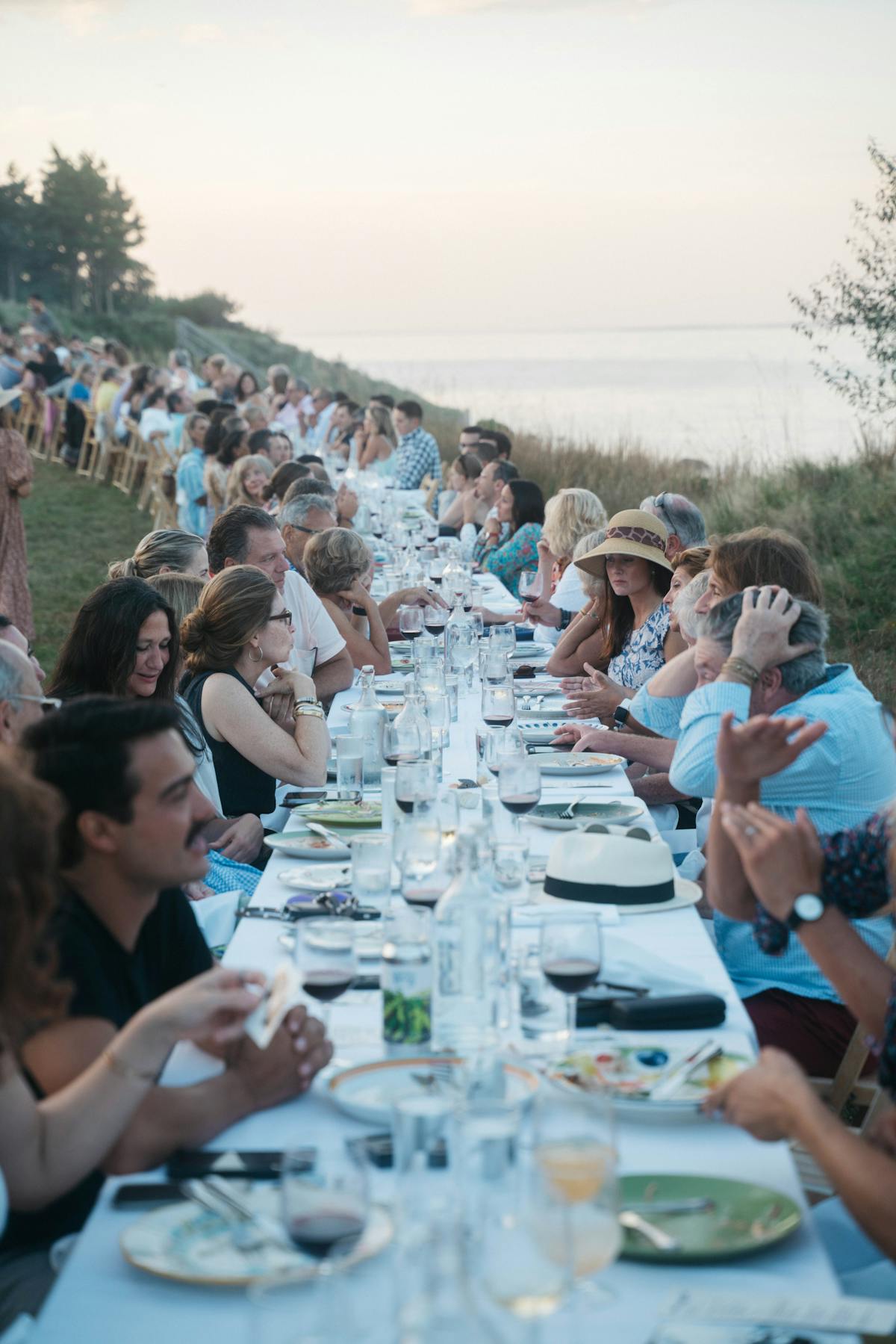The Art of the Greek Table

At Calissa, food is never just a meal — it is a ceremony, a conversation, and above all, a celebration of being together.
There is something sacred about a long table.
Not the kind you rush through, not the kind with matching plates and rigid etiquette, but the kind that stretches — in both time and space — like an invitation. A table where dishes arrive in waves. Where hands reach, glasses clink, and conversation spills like olive oil. A table where the food is just one part of the experience, and the company — in all its chaotic, affectionate noise — is the rest.
This is the Greek table. And at Calissa, it is the heartbeat of everything.
The First Invitation: A Seat at the Table
In Greece, you are never a guest for long. You arrive, and within minutes you are kin. A seat is pulled out. A plate is placed before you. Something is ladled, poured, spooned, or torn in half and shared without asking. The act of feeding someone is not a gesture. It is a bond. It says: “You are one of us now.”
This philosophy lives in every corner of Calissa.
From the first moment you arrive — wind still in your hair, salt still on your skin — there is a softness, a slowness. Aperitivo arrives unprompted. Sparkling water is poured before you think to ask. The music hums, low and coastal, like a memory. And the table? The table is ready. Always.
Mezze as Prelude, Poetry, and Provocation
The meal begins in fragments — small plates, shared spoons, casual declarations of what’s good tonight. This is mezze. And it is, perhaps, the most honest way to understand Greek hospitality.
At Calissa, the mezze arrive like musical notes — each distinct, but designed to harmonize.
There is whipped kafteri, the spicy feta dip that lingers on the lips just long enough to flirt. There are zucchini chips, impossibly thin, stacked like golden petals beside bowls of herbed yogurt. Santorini fava appears, soft and golden, warm enough to melt beneath a drizzle of olive oil, sharp with lemon, tangled with capers.
A Greek salad follows, composed with reverence: heirloom tomatoes still sun-warm, cucumbers sliced thick, slivers of onion, Kalamata olives, and a block of briny feta as white and sculptural as a Cycladic chapel. No lettuce. No invention. Just perfection.
And all of it — every dish — is placed at the center. Because the point is to reach, to ask, to offer, to take. To eat with your hands, with your laughter, with abandon. There are no first courses and no final bites. Only a meal unfolding, as meals do when no one is watching the clock.
A Symphony of Ingredients, Not Ideas
At Calissa, restraint is not austerity — it is art. There are no smears of sauce or unnecessary flourishes. The cooking speaks in clear voices: the ocean, the olive grove, the fire, the field.
The branzino for two is grilled whole — no foams, no disguise. Just fish, flesh, and flame. The meat yields like silk, lifted from bone by steady hands. It is served with lemon, oil, salt. Nothing else is needed.
The lamb chops are another kind of poetry — charred outside, blushing within, with wild oregano and tzatziki the only adornments. They arrive arranged in a crescent, accompanied by lemon potatoes that seem to glow. They are eaten with fingers, with joy, with no thought of decorum.
Even the calamari — gluten-free, light, crisp beyond belief — is treated not as a starter, but as a staple. It’s the thing you order twice, once for arrival and once after the wine starts talking.
And always, the wine.
Wine That Belongs at the Table
Greek wine is a thing unto itself. And Calissa’s list — curated with both scholarship and sensuality — is a passport to the islands, the hillsides, the sea-laced soil of a region too often overlooked.
Assyrtiko, bright and stony, is the natural companion to seafood — branzino, scallops, grilled prawns. Xinomavro brings spice and structure to lamb. Moschofilero offers florals and flirtation alongside mezze. And rosés — dry, coral-pink, sun-drenched — carry you through the evening like a tide.
The wine here is not for tasting. It is for drinking — for refilling without ceremony, for cooling your fingers on the glass while someone tells a story you don’t want to end.
There are bottles for celebrations. There are bottles for silence. There are bottles that make the table tilt in favor of another hour, another pour, another toast.
At Calissa, wine doesn’t sit at the edges. It moves with the meal, slips between courses, disappears and reappears, as if refilled by invisible hands.
The Table as Stage, Story, and Home
A Greek table does not stay still.
It grows. It shifts. It spills out onto the terrace, folds in new arrivals, drapes napkins over chairs left temporarily vacant by someone chasing a child or greeting an old friend at the next table over.
At Calissa, this living table is everywhere. It is in the clatter of forks and the break of bread, in the murmured wine suggestions and the flicker of string lights overhead. It is in the buzz of a DJ warming up after dessert, the way chairs are pushed back but no one gets up, not yet, not quite.
There is something about the atmosphere that says: “Stay.”
And so you do.
Dessert Without Endings
Dessert is not the end. Not here. Not at Calissa.
It is the soft landing, the gesture of affection, the sweet way of saying we are not quite done with each other yet.
The Calissa Ice Cream Sundae is as joyful as it sounds: Greek yogurt ice cream, tahini caramel, crumbled halva, dark chocolate, and toasted sesame. It is childhood reimagined for grownups who still know how to swoon.
There is baklava, of course — sticky, golden, fragrant with cinnamon and citrus. There is fruit, if you must. But more likely, there is one more glass of something sweet, like a Samos Vin Doux or a muscat with honeyed breath, and a question: What are you doing tomorrow?
Because the Greek table always looks forward.
The Local, the Seasonal, the Essential
The beauty of the food at Calissa — and what makes the table feel so alive — is its grounding in what’s now. Tomatoes that taste like July. Mint that still holds the morning dew. Fish that was pulled from the Atlantic just hours before. Yogurt made from sheep’s milk that’s traveled less than you have.
Gluten-free, dairy-light, seasonal by nature — the menu doesn’t bend to trends. It simply honors the ingredients that want to be here, right now. It is the quiet confidence of a kitchen that knows its rhythm, knows its land, knows that simplicity is not a compromise, but a triumph.
Why We Keep Coming Back
You don’t remember every meal you’ve had in the Hamptons.
But you remember the ones that felt like this.
Where the food was beautiful, yes — but where it also felt generous. Where the staff made you feel known. Where the table was a place to linger, not just eat. Where you lost track of time, but not conversation. Where the wine was poured before you even realized your glass was empty.
You remember Calissa. Not just what you ate, but who you were with. What you wore. What the sky looked like when you arrived. What the music sounded like as you left. What it felt like to be full, but not finished.
The Greek Table, Here and Now
To eat at Calissa is to enter into something ancient, and also something entirely present. It is not just Greek cuisine. It is the Greek way — of gathering, of offering, of tasting and talking and living in the spaces between bites.
You arrive a little tired, a little sun-drunk, a little unsure of whether you’re ready for a full meal.
But then: a table is offered. Wine is poured. The light changes. The music starts.
And you remember what the table is for.

